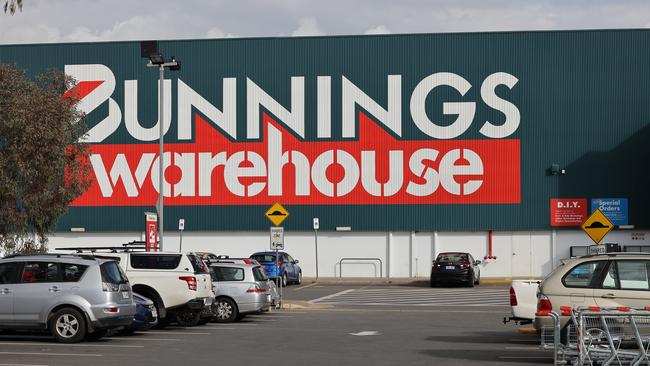Bunnings facing higher warehouse costs as wet weather dampens sales for outdoor and gardening
Bunnings ordered aggressively for spring and Christmas but wet weather has dampened sales in outdoor and gardening.

Bunnings is facing ballooning warehousing costs to store hardware stock it aggressively pre-ordered to support expected strong sales over spring and Christmas, only to see demand crimped by poor weather across much of the country.
The hardware giant has been forced to pay higher than usual rates for third-party warehouse space and in some instances book suboptimal locations as it faces heavy competition from other retailers also scrambling for space, while weakening consumer demand leaves many retail chains with bloated inventory levels.
This has led Bunnings to actively explore options to secure more of its own warehouse space rather than relying too heavily on third party providers, including the possible construction of a warehouse in South Australia.
Bunnings managing director Mike Schneider told The Australian sales for its seasonal hardware, outdoor and gardening categories had been softer due to the poor weather, which had a spill-on effect on inventories.
“As we do every year, we use warehouse space to support seasonal stock, and over time we have grown warehouse capacity in line with business growth. Given the cooler and wetter conditions in some markets, sales in outdoor-related categories have been softer, which means some of our additional warehouse capacity may be maintained. Like all retailers, we will continue to manage our stock position to ensure our customers can access the products they need.”
For Bunnings – which is also going through a round of 140 redundancies to reduce middle management and prepare for new challenges in 2023 – the cold, wet weather across the east coast of Australia has seen recent moderating sales growth for key seasonal categories such as outdoor furniture, gardening, barbecues, airconditioning and airconditioning accessories.
Fearing continued supply chain disruptions emanating from China, closed ports and other dislocations along its global links, Bunnings aggressively ordered stock to fill shelves for spring and summer, which are normally bumper months. Bunnings managers were frustrated during the worst Covid-19 periods when stock levels were less than its target of 95 per cent of all products available, and have been building inventory over the past year back to pre-Covid levels.
This has seen forward ordering of stock, making bets on demand up to a year ahead. Bunnings has been more aggressive than usual this year in its stock orders – like many retailers – due to lumpiness in the supply chain and fears over getting stock in on time.
But now conditions are changing. While some categories are growing at a double-digit pace, key hardware categories sensitive to weather conditions have slowed.
While not material to its profitability at this stage, it has left Bunnings, owned by Perth-based conglomerate Wesfarmers, with an inventory headache and more stock on hand than expected. It is now alleviating the problem by taking on more warehouse space from third-party landlords.
Bunnings has always operated a hybrid supply chain model, with its own warehouses and third-party facilities. To support peak trading and seasonal stock, Bunnings has typically used outside storage facilities for its short-term needs. However, its need for warehouse space – and therefore warehouse costs – has increased in line with its business and sales growth trajectory.
In the current environment, where industrial land is scarce, third-party warehouse costs are hundreds of thousands of dollars a month higher than usual.
Last Thursday the hardware retailer began a round of redundancies, with about 140 positions to be eliminated across five or six business units including corporate affairs, sustainability, learning and development, and human resources to slim down head office and support office functions. There will be some redeployments and natural attrition, and some vacant roles will be left unfilled. Some unfilled roles for projects in 2023 will be scrapped, and some head office staff could return to stores.
Many of the head office teams were allowed to expand during the pandemic as staff were stretched and there was a constant need for engagement with governments and regulators.
But now the Bunnings leadership believes it needs to reposition its head office and support office roles, ensuring it can maintain the historic low-cost operating model that underpinned decades of profit growth and its “lowest prices are just the beginning” market positioning.
In the current redundancies, the scale of which surprised many Bunnings insiders, Mr Schneider said it was important to reshape the business to meet changing conditions after the initial phase of the pandemic.
“Now that we’re past the most disruptive part of the pandemic, we’re reviewing our support centre resourcing to ensure we’re set up for the future. We periodically review our team resourcing, with the focus always on supporting our priorities and frontline team, so this isn’t unusual.
“Our team is incredibly important to us and we will work to minimise any impact on individuals, and our starting point is always to seek redeployment opportunities across the group.
“Overall, we continue to add roles to our business and we are still actively recruiting for teams in our store network to ensure we continue to offer customers the best experience.”
Bunnings employs about 53,000 people, including 1600 at the head office in Melbourne.
Bunnings’ performance and reshaping will be closely watched by Wesfarmers chief executive Rob Scott from his headquarters in Perth.
Although the Perth-based conglomerate has a “hands off” approach to managing directors running its businesses, Bunnings size makes its performance incredibly important to group results. Following the demerger of Coles in 2018 Bunnings has become the largest division inside Wesfarmers, driving around two thirds of earnings.




To join the conversation, please log in. Don't have an account? Register
Join the conversation, you are commenting as Logout